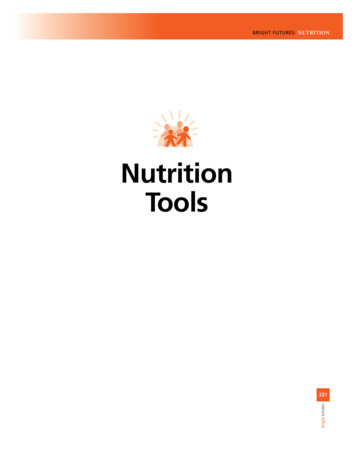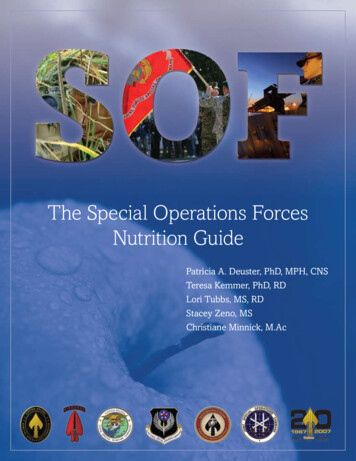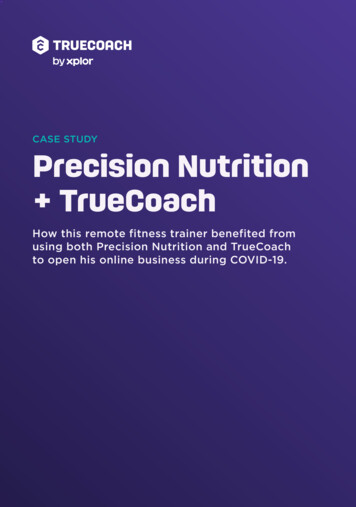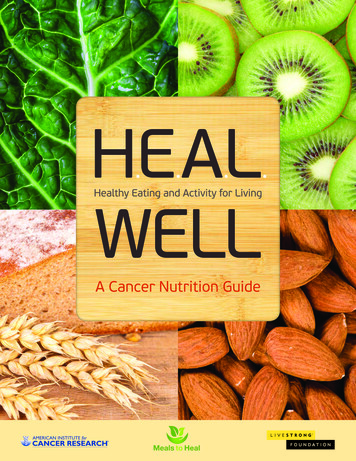
Transcription
BRIGHT FUTURES: NUTRITIONNutritionToolsBright FUTURES221
BRIGHT FUTURES: NUTRITIONNutritionQuestionnairefor InfantsTool A: Nutrition Questionnairefor InfantsTOOL AThe nutrition questionnaire for infants is a tool for parents to complete before meetingwith a health professional. The questionnaire provides a useful starting point for identifying areas of nutrition concern and determining whether additional screening is needed.When reviewing responses to the questionnaire, use the following interpretive notes toidentify areas of concern and determine follow-up questions or actions. The notes arenumbered according to their corresponding questions on the questionnaire.INTERPRETIVE NOTES223Bright FUTURES1. Feeding is crucial for the development of a healthy relationship between parentsand their infant. A parent’s responsiveness to an infant’s cues of hunger and satiation and the close physical contact during feeding facilitate healthy social andemotional development.2. Signs of hunger include hand-to-mouth activity, rooting, pre-cry facial grimaces, fussing sounds, reaching for utensils, and crying. Signs of fullness include turningthe head away from the nipple, showing interest in things other than eating, playing with food, and closing the mouth.3. Infants should be fed breast milk or iron-fortified infant formula, even in infantcereal. If infants are weaned from breast milk before age 12 months, they shouldbe fed iron-fortified infant formula rather than cow’s milk. Cow’s milk, goat’s milk,and soy milk are not recommended during the first 12 months of life.4. In establishing realistic feeding goals for infants, it is important to assess an infant’sdevelopmental readiness for eating foods with different textures as well as her self- feeding skills. Before beginning to eat from a spoon, infants should be able to holdtheir heads upright and move their tongues from side to side.5. Complementary (solid) foods can be introduced between ages 4 and 6 monthswhen the infant is developmentally ready. After the infant has accepted iron- fortified infant cereal, then pureed or soft fruits, vegetables, and meats can beoffered. Only one new food should be introduced at a time; parents should wait 3 to5 days to see how the infant tolerates the food (observe for signs of allergic reaction).There is no research to support a particular order when introducing new foods.
Tool A: Nutrition Questionnairefor InfantsBRIGHT FUTURES: NUTRITIONBright FUTURES224Between ages 6 and 12 months, infants master chewing, swallowing, and manipulation of finger foods. They begin to use cups and utensils, and while they are experimenting with newtastes and textures, their sensory and perceptual development are stimulated.6. Juice should not be given to infants younger than 6 months. After age 6 months, serve only100% fruit juice in a cup instead of a bottle and limit it to 4 to 6 oz per day. It should be offeredin small amounts (more than 6 oz per day is excessive), because too much juice may reduce theinfant’s appetite for other foods and increases the risk of loose stools and diarrhea.7. Infants permitted to suck on a bottle of any fluid that contains carbohydrates, including juiceand milk, for prolonged periods are at risk for developing dental caries (tooth decay). Infantsshould not be put to bed at night or at naptime with a bottle or allowed unlimited access to abottle (ie, permitting the infant to carry a bottle around whenever he wants).8. Honey should not be added to food, water, or formula that is fed to infants, because it can bea source of spores that cause botulism poisoning in infants. Processed foods containing honeyshould not be given to infants.9. Starting at age 6 months, infants receiving breast milk only or infant formula prepared withwater need fluoride supplementation if the water is severely deficient in fluoride. To assessfluoride levels, ask about all sources of water used by the family, including municipal, well,commercially bottled, and home system–processed water. In addition, find out whether anyready-to-feed infant formula used is manufactured with water that has little or no fluoride.Refer an infant who is not getting enough fluoride to a dentist or primary care health professional for follow-up.10–11. If inadequate cooking or food-storage facilities adversely affect a family’s nutrient intake,refer the family to social services. If a family does not have adequate resources to obtainfood, refer them to nutrition assistance programs such as the Special Supplemental NutritionProgram for Women, Infants and Children (WIC) and the Supplemental Nutrition AssistanceProgram (SNAP) or to a community food shelf or pantry. (See Tool K: Federal NutritionAssistance Programs.)12. Respond to parents’ questions and concerns.
BRIGHT FUTURES: NUTRITION1. How would you describe feeding time with your baby? (Check all that apply.) Always pleasant Usually pleasant Sometimes pleasant Never pleasant2. How do you know when your baby is hungry or has had enough to eat?Tool A: Nutrition Questionnairefor InfantsTOOL A: NUTRITION QUESTIONNAIRE FOR INFANTS3. What type of milk do you feed your baby, and how often? (Check all that apply.) Breast milk Iron-fortified infant formula Evaporated milk Whole milk Reduced-fat (2%) milk Low-fat (1%) milk Fat-free (skim) milk Goat’s milk Soy milk4. What types of things can your baby do? (Check all that apply.) Open mouth for breast or bottle Drink liquids Follow objects and sounds with eyes Put hand in mouth Sit with support Bring objects to mouth and bite them Hold bottle without support Drink from a cup that is held5. Does your baby eat solid foods? If yes, which ones?6. Does your baby drink juice? If yes, how much?7. Does your baby take a bottle to bed at night or carry a bottle around during the day?Bright FUTURES225
Tool A: Nutrition Questionnairefor InfantsBRIGHT FUTURES: NUTRITION8. Do you add honey to your baby’s bottle or dip your baby’s pacifier in honey?9. What is the source of the water your baby drinks? Sources include public, well, commercially bottled, and home system–processed water.10. Do you have a working stove, oven, and refrigerator where you live?11. Were there any days last month when your family didn’t have enough food to eat or enoughmoney to buy food?12. What concerns or questions do you have about feeding your baby or how your baby is growing?Do you have any concerns or questions about your baby’s weight?Bright FUTURES226
BRIGHT FUTURES: NUTRITIONNutritionQuestionnairefor ChildrenAges 1 to 10Tool B: Nutrition Questionnairefor Children Ages 1 to 10TOOL BThe nutrition questionnaire for children is a tool for parents to complete before meetingwith a health professional. The questionnaire provides a useful starting point for identifying areas of nutrition concern and determining whether additional screening is needed.When reviewing responses to the questionnaire, use the following interpretive notes toidentify areas of concern and to determine follow-up questions or actions. The notes arenumbered according to their corresponding questions on the questionnaire.INTERPRETIVE NOTES227Bright FUTURES1. Children grow more slowly from ages 1 to 5 than in infancy. Their appetitescan change from day to day, depending on how fast they are growing and howactive they are. As long as they are energetic and growing, they are probably getting enough of the nutrients they need. Young children often eat small portions.They should be offered small servings and should be allowed to ask for more.Irregular eating and frequently missing meals can result in an insufficientintake of calories (energy) and nutrients. Busy schedules and inadequate resourcesfor obtaining food may cause children to miss meals.2. Encourage parents to eat meals together as a family. If children see their p arentsand other adults enjoying meals together and eating a variety of foods, they willwant to do the same. Explain that being a role model is the best way to teach.Allow children to engage in age-appropriate meal preparation activities, such aswashing vegetables or helping to prepare a side dish.3. During mealtimes, a relaxed atmosphere should be maintained, and parentsshould make an effort not to rush children. Encourage parents to get rid of distractions such as television during meals. Well-balanced meals and snacksshould be offered in a pleasant environment. When children are stubborn abouteating, it is often their way of learning to be independent. Fighting over food maymake them even more stubborn.
Tool B: Nutrition Questionnairefor Children Ages 1 to 10BRIGHT FUTURES: NUTRITIONBright FUTURES2284. Children need between 4 and 6 meals andsnacks each day; these should be offeredat scheduled times and should consistof a variety of healthy foods. Childrenshould be allowed to decide whetherand how much to eat at each meal orsnack; they should not be pressured toeat certain foods or rewarded for eatingcertain foods.5. Children ages 2 to 3 need the same variety of foods and the same number ofservings as older children but may needsmaller portions—about two-thirds of aserving for each serving that older children eat. By the time children are 4 yearsold, they need serving sizes similar tothose eaten by older family members:1 slice of bread; 1 cup of raw vegetables;1 medium-sized piece of fruit; 1 cup ofmilk or yogurt; and 2 to 3 oz of cookedlean meat, poultry, or fish.Grains. Grain products provide vitamins, minerals, complex carbohydrates, and dietary fiber, which are important for good health. Children need 3 to6 oz (6–11 servings) per day of grains, ofwhich at least half should be whole grains.Vegetables. Vegetables are an important source of many nutrients, includingpotassium; folic acid; vitamins A, E, andC; and fiber. Children need 1 to 2½ cups(3–5 servings) per day.Fruits. Fruits provide vitamins, minerals, and dietary fiber. Children need1 to 1½ cups (2–4 servings) per day.Many juice beverages are not 100% juice.Parents need to check the ingredients tomake sure that they purchase juice without added sugar such as corn syrup. Ifparents purchase canned or packagedfruits, they should choose varieties withlittle or no added sugar.Milk and milk products. Milk, yogurt,cheese, and other milk products supplycalcium for building and maintainingstrong bones and teeth and protectingbones from osteoporosis. Children need2 to 3 servings per day. Children ages 1 to2 need whole milk. After age 2, childrenshould gradually increase the proportionof low-fat foods in their diets. For children older than 2, low-fat (1%) or fat-free(skim) milk is recommended. Reducedfat milk (2%) is recommended for children ages 1 to 2 years for whom obesityis a concern or who have a family historyof obesity, dyslipidemia, or cardiovascular disease.Meat and meat alternatives. Meat andmeat alternatives include both animal andplant sources of protein, iron, and otherimportant nutrients. Children need 2 to5 oz (2–3 servings) per day. Between 2and 3 oz of cooked lean meat, poultry, orfish equal one serving from this group.One egg or ½ cup of cooked dry beanscounts as 1 oz of lean meat; 2 tablespoonsof peanut butter count as 1 oz of meat.Fats and sweets. This group includesbutter, margarine, mayonnaise, vegetableoil, gravy, salad dressing, cake/ cupcakes,pie, cookies, chips, doughnuts, and candy.There is no recommended serving. Con sumption of fats and sweets should belimited. If allowed to consume sweetsin unlimited amounts, children arelikely to fill up on these rather than eathealthy foods.6. For children younger than 3, foodsthat may cause choking need to beavoided (eg, hard or chewy candy, mini- marshmallows, popcorn, pretzels, chips,spoonfuls of peanut butter, nuts, seeds,large chunks of meat, hot dogs, raw carrots, raisins and other dried fruits,whole grapes).Young children, especially 3-yearolds, are at risk for choking on foodand remain at risk until they can chewand swallow better (at about age 5).Precautions to prevent choking include Staying with children while theyare eating. Having children sit while eating,because eating while walking or running can cause choking. Keeping things calm during meal orsnack times, because becoming excitedwhile eating can cause choking. Observing children who have receivedrub-on teething medications, becausethese medications may affect chewingand swallowing.
BRIGHT FUTURES: NUTRITION229Bright FUTURES12. Children can achieve substantial healthbenefits by doing moderate- and vigorous-intensity physical activity for a totalof 60 minutes or more each day. Thisshould include aerobic activity as wellas age-appropriate muscle- and bonestrengthening (weight-bearing) activities.The benefits of physical activity includegiving children a feeling of accomplishment, reducing the risk of certain diseases(eg, diabetes mellitus, hypertension) ifthey continue to be active during adulthood, helping children achieve or maintain a healthy weight, and promotingmental health. Help the inactive childidentify enjoyable activities and incor porate them into a daily routine.13. Children who spend too much timewatching television and DVDs or playingcomputer games are likely to have a sedentary lifestyle, which can lead to overweight. These activities should be limitedto 1 to 2 hours per day.14. Watching television during mealtimes isa distraction that prevents family inter action and interferes with a child’s eating.Value the time spent together while eating. Often it is the only time during theday that families can be together.15. Respond to parents’ questions andconcerns.Tool B: Nutrition Questionnairefor Children Ages 1 to 10Avoiding eating in the car. If the parentis driving, helping a choking child willbe difficult.For children ages 3 to 5, foods thatmay cause choking can be modifiedto make them safer (eg, by cutting hotdogs in quarters lengthwise and theninto small pieces, cutting whole grapesin half lengthwise, chopping nuts finely,chopping raw carrots finely or into thinstrips, spreading peanut butter thinly on crackers or bread).7. Juice should be offered in small amountsbecause too much juice may reducea child’s appetite for food. Serve only100% fruit juice. Limit juice consumption to 4 to 6 oz per day. Parents shouldalso limit sweetened drinks such as fruitpunch, soft drinks, lemonade, and othersweetened beverages.8. Children permitted to suck on a bottleof any fluid that contains carbohydrates,including juice and milk, for prolongedperiods are at risk for developing dentalcaries (tooth decay). Children should notbe put to bed at night or at naptime witha bottle or allowed unlimited access to abottle (ie, permitting the child to carry abottle around whenever she wants).9. Children need fluoride supplementationif the water is severely deficient in fluoride. To assess fluoride levels, ask aboutall sources of water used by the family,including municipal, well, commerciallybottled, and home system–processedwater. Refer a child who is not gettingenough fluoride to a dentist or primarycare health professional for follow-up.10–11. If inadequate cooking or food- storagefacilities adversely affect a family’s nutrient intake, refer the family tosocial services. If a family does nothave adequate resources to obtain food,refer them to nutrition assistance programs such as the National SchoolLunch Program (NSLP), the SpecialSupplemental Nutrition Program forWomen, Infants and Children (WIC) andthe Supplemental Nutrition AssistanceProgram (SNAP), or to a communityfood shelf or pantry. (See Tool K: FederalNutrition Assistance Programs.)
BRIGHT FUTURES: NUTRITION2. How many days per week does your familyeat meals together?3. How would you describe mealtimes withyour child? Always pleasant Usually pleasant Sometimes pleasant Never pleasant4. How many meals does your child eat perday? How many snacks?5. Which of these foods did your child eat ordrink last week? (Check all that apply.)Grains Bagels Bread Cereal/grits Crackers Muffins Noodles/pasta/rice Rolls Tortillas Other grains:Vegetables Broccoli Carrots Corn Green beans Green salad Greens (collard, spinach) Peas Potatoes Tomatoes Other vegetables:Fruits Apples/juice Bananas Grapefruit/juice Grapes/juice Melon Oranges/juice Peaches Pears Other fruits/juice:Milk and Milk Products Fat-free (skim) milk Low-fat (1%) milk Reduced-fat (2%) milk Whole milk Flavored milk Cheese Ice cream Yogurt Other milk andmilk products:Meat and Meat Alternatives Beef/hamburger Chicken Cold cuts/deli meats Dried beans (for example, black beans,kidney beans, pinto beans) Eggs Fish Peanut butter/nuts Pork Sausage/bacon Tofu Turkey Other meat andmeat alternatives:Fats and Sweets Cake/cupcakes Candy Chips French fries Cookies Doughnuts Fruit-flavored drinks Pie Soft drinks Other fats and sweets:231Bright FUTURES1. How would you describe your child’sappetite? Good Fair PoorTool B: Nutrition Questionnairefor Children Ages 1 to 10TOOL B: NUTRITION QUESTIONNAIRE FOR CHILDREN AGES 1 TO 10
Tool B: Nutrition Questionnairefor Children Ages 1 to 10BRIGHT FUTURES: NUTRITION6. If your child is 5 years or younger, doeshe or she eat any of these foods? (Check allthat apply.) Hot dogs Marshmallows Nuts and seeds Peanut butter Popcorn Pretzels and chips Raisins Raw celery or carrots Hard or chewy candy Whole grapes7. How much juice does your child drink perday? How much sweetened beverage (forexample, fruit punch or soft drinks) doesyour child drink per day?10. Do you have a working stove, oven, and refrigerator where you live? Yes No11. Were there any days last month when yourfamily didn’t have enough food to eat orenough money to buy food?12. Did you participate in physical activity (forexample, walking or riding a bike) in thepast week? Yes No If yes, on how many days and for how manyminutes or hours per day?13. Does your child spend more than 2 hoursper day watching television and DVDs orplaying computer games? Yes NoIf yes, how many hours per day?Bright FUTURES2328. Does your child take a bottle to bed at nightor carry a bottle around during the day? Yes No14. Does the family watch television duringmeals? Yes No9. What is the source of the water your childdrinks? Sources include public, well, commercially bottled, and home system–processed water.15. What concerns or questions do you haveabout feeding your child or how your childis growing? Do you have any concerns orquestions about your child’s weight?
BRIGHT FUTURES: NUTRITIONNutritionQuestionnairefor AdolescentsAges 11 to 21Tool C: Nutrition Questionnairefor Adolescents Ages 11 to 21TOOL CThe nutrition questionnaire for adolescents is a tool for adolescents or parents to c ompletebefore meeting with a health professional. The questionnaire provides a useful s tartingpoint for identifying areas of nutrition concern and determining whether additionalscreening is needed.When reviewing responses to the questionnaire, use the following interpretive notes toidentify areas of concern and determine follow-up questions or actions. The notes arenumbered according to their corresponding questions on the questionnaire.INTERPRETIVE NOTES EATING BEHAVIORS233Bright FUTURES1–2. Irregular eating and frequently missing meals can result in a low intake of calories (energy) and nutrients. Busy schedules and inadequate resources for obtainingfood may cause an adolescent to miss meals. Reinforce the importance of eating 3meals instead of frequent snacks per day.3. Adolescents who are on their own for most meals—perhaps because of a busyschedule—may not have healthy eating behaviors. Remind adolescents and parents that family meals ensure optimal nutrition and encourage communication.Explain to parents that family meals give them the opportunity to model healthyeating behaviors.4. Shopping for and preparing food give adolescents the opportunity to learn abouthealthy food choices. Make sure the adolescent is familiar with the basic rules offood safety. (See Tool H: Basics for Handling Food Safely.)
Tool C: Nutrition Questionnairefor Adolescents Ages 11 to 21BRIGHT FUTURES: NUTRITIONBright FUTURES2345. Consumption of convenience and fastfoods is common among Americans.Frequent consumption increases fat,caloric, and sodium intake and reducesthe intake of certain vitamins and minerals. Suggest that adolescents limit theconsumption of these foods, and offersuggestions for making healthier foodchoices when eating away from home.6. If the adolescent is on a special diet, ask,“What kind of diet are you on?” This willprovide an opportunity to evaluate theadolescent’s dietary management of conditions such as diabetes mellitus or foodallergies. Refer to a registered dietitian,if appropriate.7. Individuals’ interpretations of the meaning of the term vegetarian can varygreatly. Ask adolescents who are vegetarian to name the foods they eliminate fromtheir diet as a vegetarian. Further dietaryassessment is recommended.8. Changes (either increases or decreases) inweight or appetite may indicate depression or other emotional stress, and theywarrant further assessment. Changes inweight or appetite may also indicate thatan adolescent is engaging in restrictivedieting or disordered eating, which maypredispose them to an eating disorder.Detailed dietary and psychological assessments are recommended.9. Soft drinks, fruit-flavored drinks, sportsdrinks, energy drinks, and recoverydrinks may displace healthier beverages(eg, milk, which provides calcium, protein, and vitamins; orange juice, whichis an important source of vitamin Cand folate).Food Choices10. Grains. Grains supply complex carbohydrates (which are important sources ofenergy), protein, and minerals; they alsotend to be low in fat. Whole grains area good source of dietary fiber. Six to 11servings (5–7 oz) of grains per day arerecommended; at least half of these servings should be whole grains.Vegetables. Vegetables are an important source of many nutrients, includingpotassium; folic acid; vitamins A, E, andC; and fiber. Two to 3 cups of vegetablesper day are recommended, depending onage and gender.Fruits. Fruits are important sourcesof vitamins and fiber and are low in fat.Citrus fruits and juices, strawberries, andcantaloupe are good sources of vitamin Cand folate. One and one-half to 2 cups offruits per day are recommended, based onage and gender.Milk and milk products. Milk, yogurt,and cheese are good sources of calciumand provide protein, vitamins, and minerals. Three or more servings per dayof milk and milk products are recommended. Encourage the adolescent toconsume reduced-fat (2%), low-fat (1%),or fat-free (skim) milk and other lower-fatmilk products. Adequate calcium intakeduring adolescence is essential for peakbone mass development. If the recommended calcium intake cannot be met bydiet, a supplement may be warranted. Ofthe various forms of calcium, calcium carbonate contains the highest proportion(40%) of elemental calcium by weight.Meat and meat alternatives. Red meat,poultry, fish, eggs, and dried beans provide protein, iron, zinc, and many otherminerals and vitamins. Adequate proteinintake is essential for growth and development. Two to 3 servings (or 5–6 oz) ofmeat or meat alternatives per day are recommended. Cold cuts, bacon, sausage,and fried meats are high in fat and calories; therefore, their consumption shouldbe limited.Fats and sweets. This group includesbutter, margarine, mayonnaise, vegetable oil, gravy, salad dressing, cake, cupcakes, pie, cookies, chips, doughnuts, andcandy. There is no recommended servingbecause consumption of fats and sweetsshould be limited.Food Resources11–12. If inadequate cooking or food-storagefacilities adversely affect a family’s nutrient intake, refer the family to social serv ices. If a family does not have adequateresources to obtain food, refer the familyto nutrition assistance programs such
BRIGHT FUTURES: NUTRITIONPhysical Activity16. Adolescents can achieve substantialhealth benefits by doing moderate- andvigorous-intensity physical activity for atotal of 60 minutes or more each day. Thisshould include aerobic activity as wellas age-appropriate muscle- and bonestrengthening (weight-bearing) activities.The benefits of physical activity includegiving adolescents a feeling of accomplishment, reducing the risk of certaindiseases (eg, diabetes mellitus, hypertension) if they continue to be active duringadulthood, and promoting mental health.Help the inactive adolescent identifyenjoyable activities and incorporate theminto a daily routine.Some adolescents engage in physicalactivity to compensate for caloric intakeas a form of purging. Excessive physical activity ( 2 hours per day) may leadLifestyle17. Adolescents who spend too much timewatching television and DVDs or playingcomputer games are likely to have a sedentary lifestyle, which can lead to overweight. These sedentary activities shouldbe limited to 1 to 2 hours per day.18. Watching television during mealtimes isa distraction that prevents family inter action and interferes with a child’s eating.Value the time spent together while eating. Often it is the only time during theday that families can be together.19. If the adolescent uses vitamin, mineral,herbal, or other dietary supplements,ask about the kind, dosage, length of use,and reason for use. Encourage the adolescent to eat healthy foods instead ofusing supplements to obtain nutrients.If the adolescent is interested in vitaminsupplements, emphasize the importanceof using low-dose supplements and theneed to avoid high doses (particularly ofvitamin A), which can be toxic.Adolescents who engage in physical activities in which strength is a critical factor (eg, football, weightlifting)may consume a high-protein diet ortake protein supplements in an attemptto increase strength and muscle mass.However, increased protein intake doesnot affect muscle size.Adolescents who use protein supplements should be asked about anabolic steroid use. Some adolescents take anabolicsteroids to enhance their strength, musclesize, and endurance. Steroid use can causeside effects, including acne, deepening ofthe voice, and hair recession.20. Unhealthy behaviors occur in clustersin adolescents. For example, adolescents who smoke are more likely to haveunhealthy eating behaviors and low levels of physical activity. Adolescents whosmoke to lose weight need counseling onboth smoking and healthy weight management. Cigarette smoking also increasesthe need for vitamin C.235Bright FUTURESWeight and Body Image13. Some adolescents may be dissatisfied withtheir weight and use unhealthy meansto alter it. If the adolescent expresses a concern about weight, follow up withquestions such as “How would you classify your weight?” or “Are you doing anything to try to change your weight?”14. If the adolescent is dieting, determinethe frequency, duration, and methodsof weight loss. Chronic food restrictionand inadequate energy intake may causepoor growth, delayed sexual development, menstrual irregularities, poor concentration, irritability, sleep difficulties,and constipation. Frequent dieting maybe associated with binge eating. Purging(eg, self-induced vomiting, laxative use)may be associated with other risk behaviors (eg, substance use, suicide attempts).15. Self-induced vomiting; the use of laxatives, diuretics, or diet pills; or bothare warning signs of eating disorders.Adolescents who engage in these behaviors need further assessment.to fatigue, loss of appetite, or menstrualirregularities and may be a sign of an eating disorder.Tool C: Nutrition Questionnairefor Adolescents Ages 11 to 21as the National School Lunch Program(NSLP) and the Supplemental NutritionAssistance Program (SNAP), or to a community food shelf or pantry. (See Tool K:Federal Nutrition Assistance Programs.)
Tool C: Nutrition Questionnairefor Adolescents Ages 11 to 21BRIGHT FUTURES: NUTRITIONBright FUTURES23621. If the adolescent admits to using alcohol or street drugs, screen for substanceabuse, and refer for counseling and treatment. (Refer to CRAFFT, a behavioralhealth screening tool for use with children and adolescents younger than 21).Some adolescents take anabolic steroids to enhance their strength, musclesize, and endurance. Steroid use can causeside effects, including acne, deepening ofthe voice, and hair recession. Emphasizethe dangers of steroid use to adolescentswho engage in strenuous physical activity to build muscle or who participate insports in which strength is a critical factor(eg, football, weightlifting).
BRIGHT FUTURES: NUTRITION2. Do you skip breakfast 3 or more times aweek? Yes NoDo you skip lunch 3 or more times a week? Yes No Do you skip dinner or supper 3 or moretimes a week? Yes No3. Do you eat dinner or supper with your family 4 or more times a week? Yes No4. Do you fix or buy the food for any of yourfamily’s meals? Yes No5. Do you eat or take out a meal from a fastfood restaurant 2 or more times a week? Yes No6. Are you on a special diet for medicalreasons? Yes No7. Are you a vegetarian? Yes No8. Do you have any problems with your appetite, like not feeling hungry, or feelinghungry all the time? Yes No9. Which of the following did you drink lastweek? (Check all that apply.) Tap or bottled water Fitness water Juice Regular soft drinks Diet soft drinks Fruit-flavored drinks Sports drinks Energy drinks Recovery drinks Fat-free (skim) milk Low-fat (1%) milk Reduced-fat (2%) milk Whole milk Flavored milk (for example, chocolate,strawberry) Coffee or tea Beer, wine, or hard liquor10. Which of these foods did you eat last week?(Check all that apply.)Grains Bagels Bread Cereal or grits Crackers Muffins Noodles, pasta, or rice Rolls Tortillas Other grains:Vegetables Broccoli Carrots C
lean meat, poultry, or fish. Grains. Grain products provide vitamins, minerals, complex carbohy-drates, and dietary fiber, which are impor-tant for good health. Children need 3 to 6 oz (6–11 servings) per day of grains, of which at least half should be whole grains. Vegetables. Vegetab











